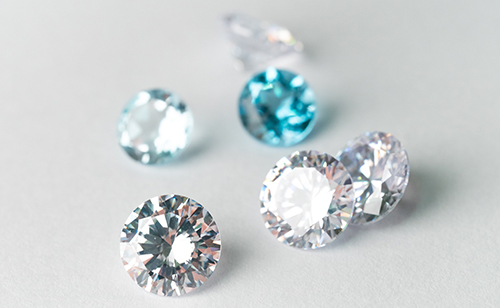Diamond is considered to be the king of gems, mainly because of its brilliance and rarity. The word diamond comes from the ancient Greek word "Adamas" which means irresistible because of its hardness as a material. It is located on the top of the Mohs scale (at No 10), which measures how hard the minerals are. This means that the only way to scratch a diamond is with another diamond.
Natural diamonds are created in the mantle of the earth, in the region between the core and the crust. The intense pressure and the high temperatures prevailing in the mantle of the earth change the molecular structure of the carbon, obliging its molecules to acquire a crystalline structure. The temperature required to convert carbon to diamond exceeds 1,400 degrees Celsius.
The distance between the mantle of the earth, where the diamonds and the surface are created, is over 160 km. Diamonds come to the surface with the help of diamond-shaped igneous rocks, which are formed either from volcanic lava or inside the magma. The most well-known pyrogenetic rock is the Kimberlite. When the kimberlite ascends to the surface of the earth in a semi-solid state, it brings along diamonds. These are the primary diamond deposits where the gemstones are located in the vein of the kimberlite.
Water can erode the soil where the primary deposits lie and drag the diamonds even several miles away, along the banks of rivers, deltas, lakes, and even the seaside. These are the secondary diamond deposits, called alluvial deposits, and are the places where humans found diamonds for several centuries before deciding to proceed with their systematic search.

In the late 19th century, when large diamond deposits were discovered in the Kimberley region of South Africa, the systematic mining of diamonds and the organization of production began using new and modern methods. The main diamond mining countries today are Russia, China, India, the Democratic Republic of Congo, South Africa, Brazil, and Australia.
There are four factors that affect the value of a diamond, which are internationally known as the 4C's, Carat, Color, Cut, and Clarity.
The weight of diamonds is measured in carats. Because large natural diamonds, especially those composed exclusively out of carbon are quite rare and at the same time sought after, the price per carat increases geometrically with the carat increase of the diamond.
Diamonds in their natural state are opaque, transparent, or translucent and have a wide variety of colors from completely colorless, gray, blue, red, yellow, green, or black. In jewellery mainly colorless and transparent diamonds are used, although in recent years colorful diamonds and even black have become quite popular.
During the diamond creation, it is possible for foreign elements to be trapped inside the gem and they become part of the diamond and are called inclusions. Also, the clarity of the diamond and hence its value is affected by the presence of defects on its surface.
Cutting is the process that will give a diamond its final shape and polish that will bring out its glow. The correct cut of the diamond will not only give it the right shape, but it will also remove or capitalize on the inclusions and defects, and in particular will allow the light to pass through the diamond and be reflected from it, resulting in a unique glow.

The Diamond Industry deals with diamond processing, but also with their evaluation and Wholesale and retail sale. The countries with the highest diamond exports are Belgium, India, Israel, Russia, United Arab Emirates, South Africa, USA, Hong Kong, Botswana, and others.
The oldest and most important company in the diamond business is De Beers, founded in 1888 by British Cecil Rhodes. Today, the company is active in the diamond mining sector but also in the processing, wholesale, and retail of diamonds. De Beers controls over 40% of the diamond mines and a large part of the wholesale diamond trade.
In the 20th century, diamond demand grew considerably, mainly due to the introduction of the diamond ring as the most popular engagement jewellery. The fact that it is the toughest mineral has helped the diamond get the definition of "eternal" and that is why it has been associated with everlasting love and marriage.